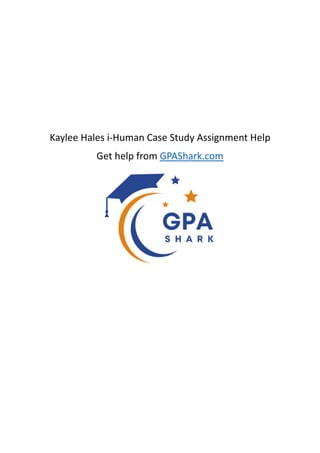kaylee hales i-human case study assignment help.pdf
The "Kaylee Hales i-Human Case Study" is a pivotal component in medical education, designed to test and enhance students' clinical reasoning, diagnostic skills, and patient management abilities. This case study presents a complex scenario where Kaylee Hales, a fictional patient, presents with multifaceted health issues that require a meticulous and systematic approach for accurate diagnosis and effective treatment. At GPAShark.com, we provide specialized assistance to help students navigate these challenging assignments with confidence and achieve academic excellence. Understanding the Kaylee Hales i-Human Case Study The Kaylee Hales case study is an immersive learning tool that simulates real-life clinical scenarios. It requires students to perform comprehensive patient evaluations, including history taking, physical examination, diagnostic testing, and developing a management plan. The primary goal is to equip students with the skills needed to handle complex clinical cases in their future medical careers. Benefits of Mastering the Kaylee Hales Case Study Mastering the Kaylee Hales i-Human Case Study not only helps you excel academically but also prepares you for real-world clinical practice. The skills you develop through this case study are directly applicable to your future career as a healthcare professional. These include: Improved Diagnostic Accuracy: By systematically evaluating symptoms and performing thorough examinations, you increase your ability to make accurate diagnoses. Enhanced Clinical Reasoning: Developing a logical approach to diagnostic reasoning ensures you can think critically and make informed decisions. Effective Patient Management: Creating evidence-based management plans prepares you to provide high-quality patient care. Strong Communication Skills: Effectively communicating with patients and healthcare teams is crucial for successful clinical practice.
Related slideshows

More Related Content
Similar to kaylee hales i-human case study assignment help.pdf
Similar to kaylee hales i-human case study assignment help.pdf (20)
More from Reliable Assignments Help
More from Reliable Assignments Help (14)
Recently uploaded
Recently uploaded (20)
kaylee hales i-human case study assignment help.pdf
- 1. Kaylee Hales i-Human Case Study Assignment Help Get help from GPAShark.com
- 2. Kaylee Hales i-Human Case Study The "Kaylee Hales i-Human Case Study" presents a complex medical scenario designed to challenge and enhance the clinical skills of medical students. The case involves Kaylee Hales, a fictional patient with a multifaceted health issue that requires a detailed and systematic approach for accurate diagnosis and effective treatment. This case study is crucial for developing diagnostic acumen, clinical reasoning, and patient management skills. However, students often face significant difficulties in navigating the intricacies of this case, necessitating a structured problem statement to guide their approach. Kaylee Hales i-Human Case Study Problem Statement The primary problem in the "Kaylee Hales i-Human Case Study" is the multifactorial nature of Kaylee's presenting symptoms, which require a comprehensive evaluation to identify the underlying condition accurately. Kaylee presents with a constellation of symptoms that may be indicative of multiple potential diagnoses, making it challenging for students to pinpoint the exact cause without a thorough and methodical approach. Kaylee Hales i-Human Case Study Key Challenges 1. Complex Symptomatology: o Kaylee's symptoms are diverse and may overlap with several medical conditions, increasing the difficulty of formulating an accurate differential diagnosis. Students must distinguish between similar presenting symptoms to avoid misdiagnosis. 2. Comprehensive History Taking: o Gathering a detailed and relevant patient history is critical but challenging. Students must identify key elements in Kaylee's medical, family, and social history that could provide crucial diagnostic clues. 3. Thorough Physical Examination: o Performing a detailed physical examination to identify any abnormal findings is essential. Students must be adept at recognizing subtle signs that may indicate specific medical conditions. 4. Diagnostic Reasoning: o Formulating a differential diagnosis requires critical thinking and the ability to integrate patient history, physical examination findings, and diagnostic test results. Students must prioritize potential diagnoses and determine the most appropriate diagnostic tests. 5. Evidence-Based Management: o Developing an effective management plan for Kaylee involves selecting evidence- based treatments and interventions. Students must balance the need for immediate symptom relief with long-term management strategies, considering the patient's overall health and preferences. Objectives • Accurate Diagnosis: To accurately diagnose Kaylee's condition by systematically evaluating her symptoms, history, and examination findings.
- 3. • Effective Treatment Plan: To develop a patient-centered, evidence-based treatment plan that addresses Kaylee's current symptoms and promotes her long-term health. • Patient Education and Communication: To effectively communicate the diagnosis, treatment options, and management plan to Kaylee, ensuring she understands and is comfortable with the proposed approach. • Clinical Competence: To enhance the clinical skills of medical students, preparing them for real-world scenarios where they must manage complex cases with confidence and competence. Kaylee Hales i-Human Case Study Assignment Help The "Kaylee Hales i-Human Case Study" is an essential learning tool that encapsulates the complexities of patient care. Addressing the primary problem requires a structured approach that encompasses comprehensive history taking, thorough physical examination, accurate diagnostic reasoning, and evidence-based management. By overcoming these challenges, medical students can develop the skills necessary to provide high-quality care in their future clinical practice. At GPAShark.com, we provide expert guidance and resources to help students excel in this and other i- Human case studies, ensuring they are well-prepared for their medical careers.